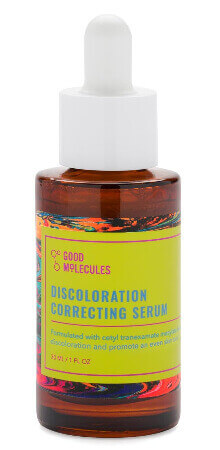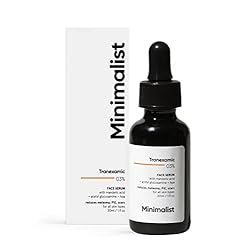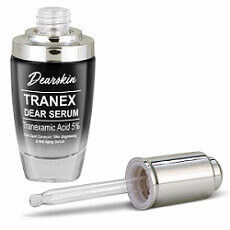In recent months, a discoloration serum from Good Molecules has garnered significant online discussion. There are numerous internet testimonials and reviews about this product that treats hyperpigmentation and uneven skin tone.
Discoloration Serum Corrector from Good Molecules

Discoloration serums can treat dark spots and skin discoloration related issues. A company named Good Molecules has developed a solid reputation in making skin products that are cruelty-free and contain no harmful ingredients. Moreover, their products are all very reasonably priced.
The Good Molecules Discoloration Correcting Serum currently has almost 2,080 reviews on Amazon, with an average rating of 4.3 out of 5 stars. The product is fragrance free, vegan and contains tranexamic acid and niacinamide. It is advertised as being helpful in treating dark spots, acne scars, sunspots, hyperpigmentation and age spots. The current discounted price is only $12 for a 30 ml (1 oz) bottle. Quite reasonable for such a popular product.
Key Ingredients in Good Molecules Discoloration Serum
The key ingredients in Good Molecules Discoloration Serum are as follows:
- 3% tranexamic acid (cetyl tranexamate mesylate). This targets skin discoloration and helps promote a clear skin tone. Make sure to read my post on tranexamic acid for skin lightening.
- 4% niacinamide to improve the appearance of uneven skin tone, dullness and enlarged pores. Niacinamide is a key ingredient in numerous products that help reduce hyperpigmentation in people with dark skin.
Cetyl Tranexamate Mesylate
Note that one of the two ingredients in this product is an interesting new derivative of tranexamic acid (TXA). It is called cetyl tranexamate mesylate. On Good Molecules website, it is classified as a melanin inhibitor, skin conditioning agent and astringent. They call it a “first of its kind anti-aging depigmentation active” that results in a naturally even skin tone.
A 2021 US study analyzed the safety and skin-lightening performance of this new topical TXA derivative cetyl tranexamate mesylate. It found that when using the facial serum twice a day for 8 weeks (35 female subjects):
Melanin and erythema indexes improved significantly and continuously from the baseline to the end of the study (-16.9% and -34.3%, respectively).
The topical serum containing cetyl tranexamate mesylate caused no adverse reacions or side effects. Moreover, it significantly improved overall facial skin tone and the appearance of dark spots and redness.
Do note that according to Paula’s Choice, despite showing promise, more research is needed before this tranexamic acid derivative can be assessed as thoroughly as TXA itself.
Other Pigment Corrector Products
Among other related pigment corrector product, “Topicals” has a faded discoloration serum that is also quite popular. It also contains tranexamic acid and niacinamide and can treat dark spots, blemishes and skin discoloration.
Its skin brightening effect is enhanced by the use of azelaic acid. You can also purchase it on Sephora, where it currently has 1,500 reviews. This faded discoloration serum from Topicals is safe to use daily on all ethnicities and skin shades.
Paula’s Choice makes a discoloration repair serum that contains tranexamic acid and botanical ingredient bakuchiol. The latter is a gentler alternative to retinoids. The skin repair product claims to visibly reduce patches of discoloration that can appear on the cheeks, forehead, nose and chin.

